The Fed’s reaction function and why I am not talking about US recession yet
Ever since Willem Buiter’s call for a global recession within the next two years, people have been parsing the data for some indication that the US has been fatally compromised by contagion from emerging markets. Nothing in Buiter’s piece talked of outright recession in the US. Rather, he talked of global growth slowing to a 2% annual rate. Therefore, the US’s not entering recession would be fully consistent with his global recession call. At this point, it isn’t clear where the US will be two years from now. The most we can say is there are signs of slowing inconsistent with a rate hike. I will explain in chart form below.
Let me set the agenda here using some comments I wrote seven years ago about the four horsemen of economic data when I was predicting recession. Here’s what I wrote:
“The National Bureau of Economic Research (NBER) is the official arbiter of business cycles in the U.S. If you want to know when a recession occurs, it is the NBER which decides. The NBER relies on understanding four major economic data trends — the economy’s four horsemen:
- How much we spend: retail sales
- How much we earn: real earnings growth
- How much we make: industrial production
- How much we work: employment
“But note, the NBER makes its analysis of these cycles to only determine when a business cycle peak has occurred and when a trough has occurred. Its recession call does not indicate when the rate of economic growth is slowing, which is the thing you want to know. Moreover, the NBER dates whether recession occurred only after the fact. That doesn’t do you much good if you are looking to act based upon where the economy is headed.”
From an investment or business planning perspective, you care as much about slowing as you do about outright recession because you need to be ahead of the curve. Here’s what a recession is, according to the NBER:
“A recession is a period between a peak and a trough, and an expansion is a period between a trough and a peak. During a recession, a significant decline in economic activity spreads across the economy…
[…]
The Committee does not have a fixed definition of economic activity. It examines and compares the behavior of various measures of broad activity: real GDP measured on the product and income sides, economy-wide employment, and real income.”
I am, therefore, looking at whether the economy is slowing materially using this particular definition, using trend data series for the last two years of available data.
Output
When we look at the business side of things, I have a couple of data series: trend nominal GDP growth and industrial production.
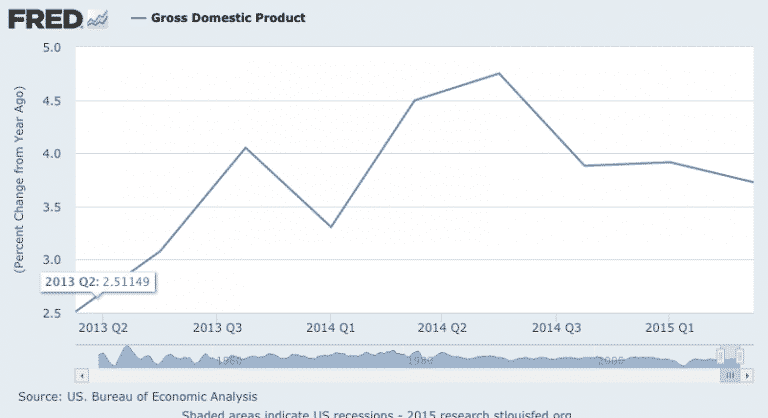
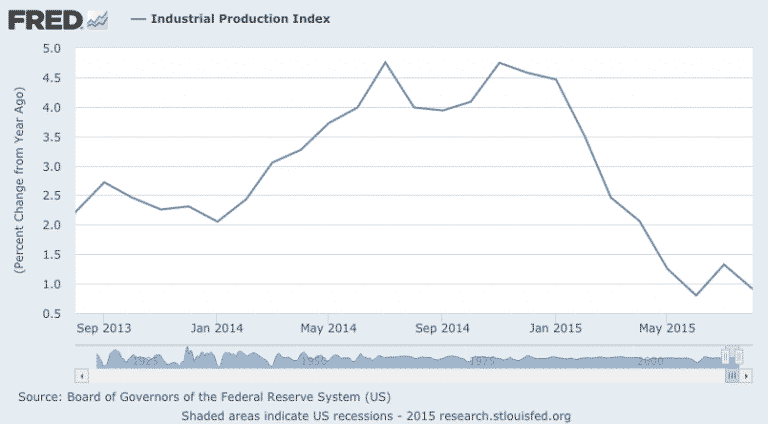
I look at trend nominal GDP growth as the single most useful data series for looking at trend. And this trend is clearly down since the middle of 2015. The same is also true for industrial production. For me, both of these time series are indicators that the US economy has slowed materially in the wake of the end of quantitative easing and the forward guidance on future rate hikes. The question at this point is whether this trend continues, and if so, for how long. Note that corporate earnings growth is now down. If you combine this with the decline in output, it would suggest a slowing of hiring that is on the verge of turning into an increase in the level of involuntary employment terminations. The output data are saying: “We are not there yet, but we could be soon.” And this is what we see from the jobs data.
Jobs
If you look at the two major time series for jobs, non-farm payrolls and jobless claims, they represent the two opposite sides of the jobs picture. One is about the level of hiring and the second is about the level of firing. What we should expect in a mid-cycle slowing is that rolling 12-month job growth would trend down. And this is how the non-farm payrolls series looks.
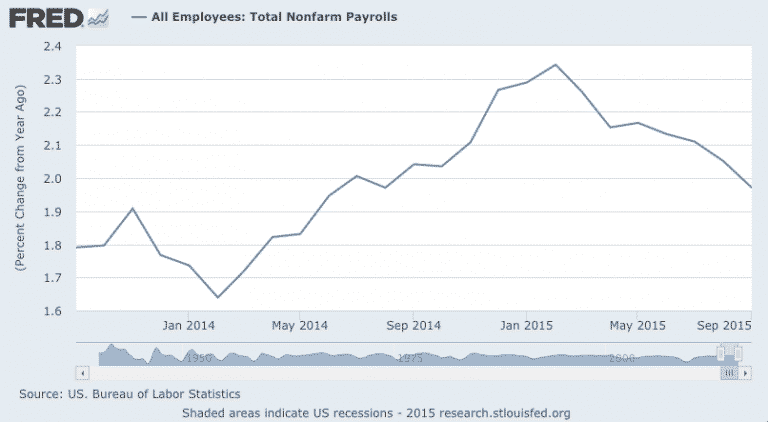
But as long as initial jobless claims remain low and stable, we can still consider this to be a mid-cycle slowdown. It is when the initial jobless claims tick up that we know that the jobs picture has deteriorated. Now clearly, if we get a large exogenous shock that forces up jobless claims very suddenly, recession could hit without a jobless claims warning. However, I believe that we will need to see a deterioration in the jobless claims data to be overly concerned about recession without such a shock. And we don’t have that – just the opposite.
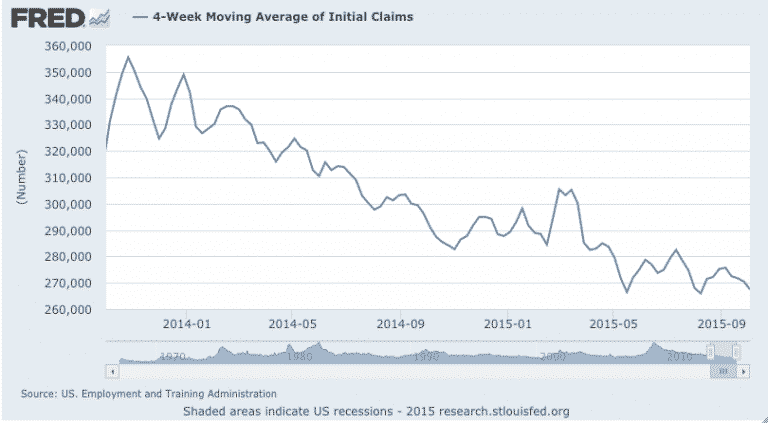
So, yes the output numbers have weakened and caused trend job growth to decline. But the uptick in involuntary separations is not in the data yet.
Consumer spending
When looking at the consumer side, to track trend growth I have the more comprehensive data series, the personal consumption expenditures and the retail sales data series, which is more limited. These are both in nominal terms.
My overall assessment of these two time series is that they both show material slowing starting at the end of 2014, about the same time that the price of oil began to drop. I do not think this is a coincidence because the drop in oil prices coincided with a steep fall in capital expenditure that I believe filtered through the economy as weak consumer spending and retail sales growth, despite the additional disposable income consumers had. The evidence, therefore, seems to support the conclusion that the drop in oil prices was on net a negative shock for the US economy, due to its impact on oil production, and related jobs and capital expenditure and the flow through to the broader economy.
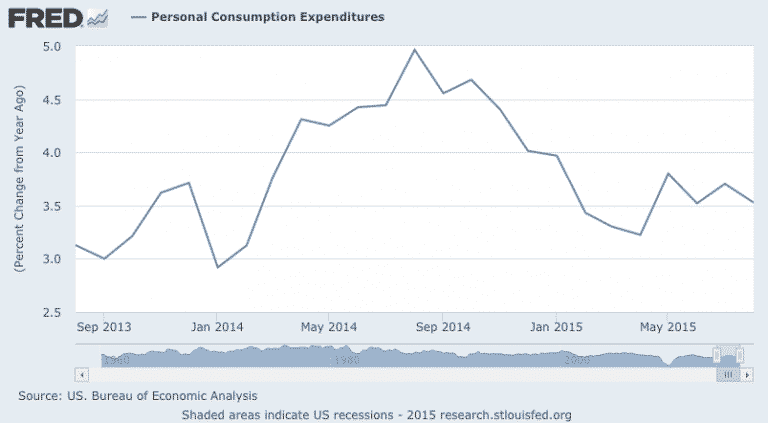
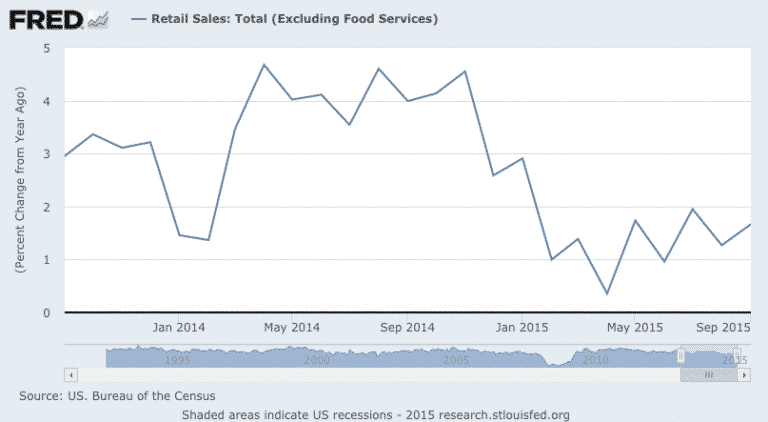
I have been waiting for the consumer dividend from lower oil prices to assert itself due to the increase in disposable income from economic agents with greater marginal propensity to consume. But the evidence suggests that, even if this dividend has indeed occurred, it has been overwhelmed by the negative shocks from the oil price shock. On the positive side, trend retail sales growth seems to be slightly higher since May 2015. But the overall trend in PCE growth is inconclusive.
Wages
Looking at wage growth, I also have two data series: average hourly earnings of non-supervisory employees and compensation of employees in salary and disbursements.
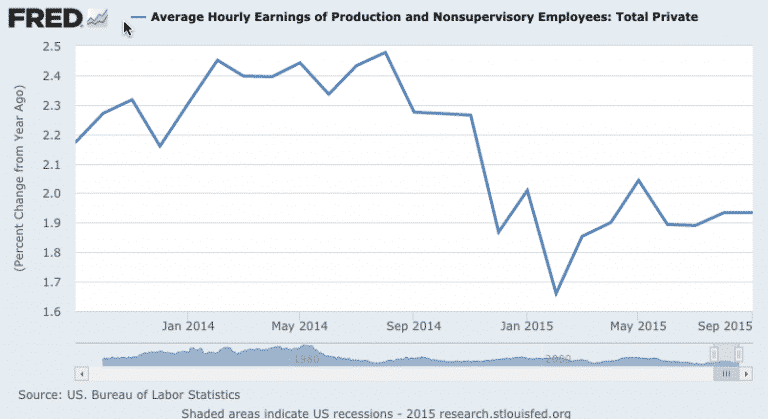
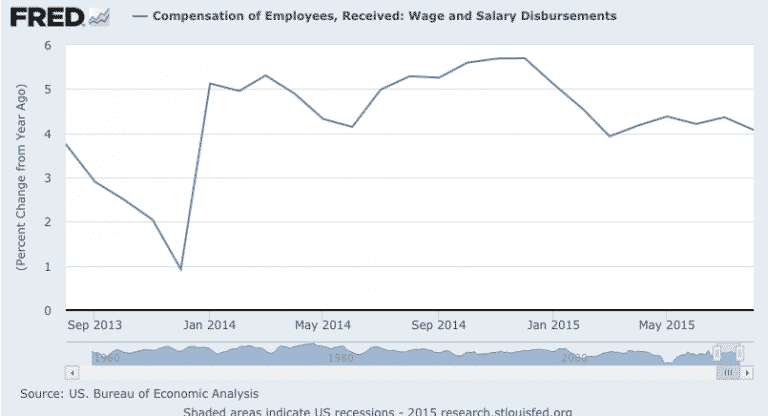
The general trend here since the beginning of 2014 seems to be down. I would call these two data series inconclusive in terms of what they say about trend wage growth. The Fed is looking closely at trend wage growth as it believes that it should raise rates before trend wage growth accelerates too quickly. Leaving aside whether that is the right approach, I will say that there is no evidence that this is a risk the Fed needs to take into account at this time.
The Fed’s reaction function
Here are the conclusions that pertain to monetary policy:
- I believe the data support the thesis that tapering was tightening, not just in terms of cross-border flows and currency moves, but also in terms of trend growth in the US economy. The same is true for hawkish forward guidance.
- Because monetary policy acts with a lag, it is not clear how much of the previous Fed tightening is baked into the data. We could be in a mid-cycle slowing with growth about to recover shortly. Or there could be more weakness ahead. The trends in the data sets here are inconclusive on that score.
- I believe the Fed is aware of these data and that it has backed away from raising rates at least in part for this reason. Until we see a clear uptick in both trend nominal GDP growth and wages, I believe we will continue to hear more dovish comments from the Fed.
- The earliest the Fed will raise rates now is December. As such, if the Fed decides to raise rates because the hawks win out, the monetary policy lag means that we will not know the full impact of this tightening until election time in 2016. Thus, a rate decision will have a material impact on the tenor of the US presidential election race. Republican frontrunner Donald Trump is already talking about recession, by the way. I believe more slowing from here would be negative for the Democrats.
- I continue to see the initial claims data as the last bastion of unadulterated bullishness for the US economy. This time series has been consistently strong, sending a positive message about the health of the employment picture. If it gives way, we should anticipate more economic weakness, something bullish for safe and near-safe US assets and bearish for equities and junk and other risk assets.
Comments are closed.